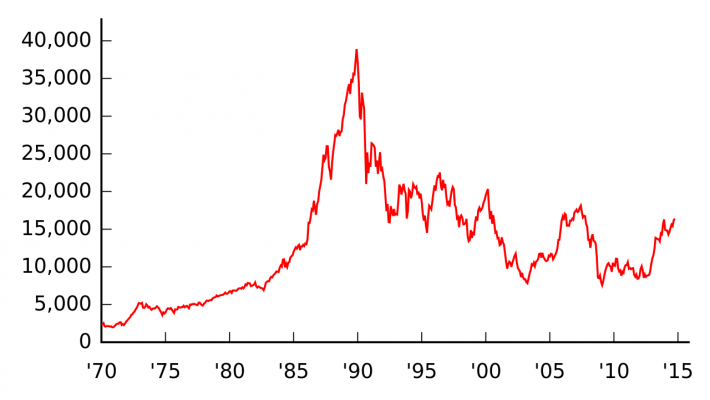In the mid 1980’s economists believed Japan would surpass the United States to become the world’s largest economy. Japan did not grow as planned. The image below shows how the Nikkei 225 (Japan’s version of the S&P 500) is down about 50% since high’s around 1989.

Source:Â Wikimedia Commons
Japan’s economy has been stagnant for about 25 years. The country is facing 3 issues that threaten to further weaken the country’s economy.
Issue #1: Extreme Debt
Japan has the highest debt to GDP ratio of any country in the world. Japan is more indebted than both Zimbabwe and Greece. The country’s debt to GDP ratio is currently well over 200%. The image below shows Japan’s almost continuous rise in debt as a percentage of GDP over the last 35 years.

Source:Â Trading Economics
Japan’s debt is a looming problem for the country. Taking on debt is inter-generational borrowing. Citizens of Japan today are borrowing against future generations’ earnings power. This is not sustainable indefinitely.
High debt levels mean interest rates must be kept low. With low interest rates, current tax revenue can cover interest expenses on debt. If interest rates rise, Japanese bonds will lose value. The country will find it difficult to continue issuing debt at higher interest rates – interest expense will take up a greater share of the country’s tax revenue.
Issue #2: Declining Population
Japan’s birth rate is lower than its death rate. One million babies were born in Japan in 2014 while 1.27 million people died. For comparison in 2010 (the most recent year with data for both birth and death) 4 million babies were born in the United States and 2.468 million people died. The Japanese population is expected to decline from 127 million today to 97 million by 2050.
Population decline means less productive citizens generating fewer new ideas, businesses, scientific advances, products, and services. Population growth is a net positive for the economy. Population decline hurts economies.
Population declines by themselves are troublesome. Declining population coupled with rising debt is even more troublesome. As debt grows while the number of citizens shrink, each Japanese citizen will have a more onerous debt burden. The percentage of tax revenue from each citizen that goes to paying interest on debt will keep rising as the population decreases.

